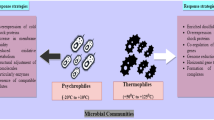Abstract
Microorganisms are continuously exposed to numerous stress conditions and had evolved with numerous evolutionary adaptations and physiological acclimation mechanisms against stress effects. Any information related to the microbes responsive to stress conditions will help scientists working in the area of stress biology. Currently, there is lack of information resource on this aspect and for getting information about microbes susceptible or tolerant to different environmental changes, literature searching is the only option. Here, we present a database StressMicrobesInfo that was developed with a mandate to provide information about microbes responding to various biotic and abiotic stress conditions. This database currently contains information about 183 microbes along with a brief detail for each. StressMicrobesInfo will facilitate researchers working on stress-related microbes as a starting point and will facilitate them with the microbes which are susceptible or resistant towards particular stress conditions.


Similar content being viewed by others
References
Schimel J, Balser TC, Wallenstein M (2007) Microbial stress-response physiology and its implications for ecosystem function. Ecology 88:1386–1394
Prabha R, Singh DP, Keshri V, Sevyaa, Sharma AK (2014) Bioinformatics resources for the management of biological information on plant responses towards stresses. In: Gaur RK, Sharma P (eds) Approaches to plant stress and their management. Springer, India. pp 365–382
Moat AG, Foster JW, Spector MP (2002) Microbial stress responses. In: Moat AG, Foster JW, Spector MP (eds) Microbial physiology. Wiley, New York. pp 582–611
Hoffmann AA, Willi Y (2008) Detecting genetic responses to environmental change. Nat Rev Genet 9:421–432
Mitchell A, Romano GH, Groisman B, Yona A, Dekel E, Kupiec M, Dahan O, Pilpel Y (2009) Adaptive prediction of environmental changes by microorganisms. Nature 460:220–224
Jordan S, Hutchings MI, Mascher T (2008) Cell envelope stress response in Gram-positive bacteria. FEMS Microbiol Rev 32:107–146
Swiecilo A, Zych-Wezyk I (2013) Bacterial stress response as an adaptation to life in a soil environment. Pol J Environ Stud 22:1577–1587
Ramos JL, Gallegos M, Marqués S, Ramos-González M, Espinosa-Urgel M, Segura A (2001) Responses of Gram-negative bacteria to certain environmental stressors. Curr Opin Microbiol 4:166–171
Hecker M, Völker U (2001) General stress response of Bacillus subtilis and other bacteria. Adv Microb Physiol 44:35–91
Beales N (2004) Adaptation of microorganisms to cold temperatures, weak acid preservatives, low ph, and osmotic stress: a review. Compr Rev Food Sci F 3:1–20
Kültz D (2005) Molecular and evolutionary basis of the cellular stress response. Annu Rev Physiol 67:225–257
Cabiscol E, Tamarit J, Ros J (2000) Oxidative stress in bacteria and protein damage by reactive oxygen species. Int Microbiol 3:1
Mayak S, Tirosh T, Glick BR (2004) Plant growth-promoting bacteria confer resistance in tomato plants to salt stress. Plant Physiol Biochem 42:565–572
Huang J, Rozelle S (1995) Environmental stress and grain yields in china. Am J Agr Econ 77:853–864
Kennedy AC, Smith KL (1995) Soil microbial diversity and the sustainability of agricultural soils. Plant Soil 170:75–86
Mittler R (2006) Abiotic stress, the field environment and stress combination. Trends Plant Sci 11:15–19
Prabha R, Ghosh I, Singh DP (2011) Plant Stress Gene Database: a collection of plant genes responding to stress condition. ARPN J Sci Technol 1:28–31
Glick BR (1995) The enhancement of plant growth by free-living bacteria. Can J Microbiol 41:109–117
Foster PL (2005) Stress responses and genetic variation in bacteria. Mutat Res 569:3–11
Yang J, Kloepper J, Ryu CM (2009) Rhizosphere bacteria help plants tolerate abiotic stress. Trends Plant Sci 14:1–4
Giller KE, Witter E, Mcgrath SP (1998) Toxicity of heavy metals to microorganisms and microbial processes in agricultural soils: a review. Soil Biol Biochem 30:1389–1414
Grover M, Ali S, Sandhya V, Rasul A, Venkateswarlu B (2011) Role of microorganisms in adaptation of agriculture crops to abiotic stresses. World J Microbiol Biotechnol 27:1231–1240
Compant S, Duffy B, Nowak J, Clément C, Barka EA (2005) Use of plant growth-promoting bacteria for biocontrol of plant diseases: principles, mechanisms of action, and future prospects. Appl Environ Microbiol 71:4951–4959
de Zelicourt A, Al-Yousif M, Hirt H (2013) Rhizosphere microbes as essential partners for plant stress tolerance. Mol Plant 6:242–245
Singh DP, Prabha R, Rai A, Arora DK. 2012. Bioinformatics-assisted microbiological research: tasks, developments and upcoming challenges. Am J Bioinform 1:10–19
Ouzounis C (2002) Bioinformatics and the theoretical foundations of molecular biology. Bioinformatics 18:377–378
Bansal A (2005) Bioinformatics in microbial biotechnology—a mini review. Microb Cell Fact 4:19
Rhee SY, Crosby B (2005) Biological databases for plant research. Plant Physiol 138:1–3
Priya P, Jain M (2013) RiceSRTFDB: a database of rice transcription factors containing comprehensive expression, cis-regulatory element and mutant information to facilitate gene function analysis. Database, bat027
Borkotoky S, Saravanan V, Jaiswal A, Das B, Selvaraj S, Murali A, Lakshmi PTV (2013) The Arabidopsis stress responsive gene database. Int J Plant Genom 2013
Kumar SA, Kumari PH, Sundararajan VS, Suravajhala P, Kanagasabai R, Kishor PBK (2014) PSPDB: Plant Stress Protein Database. Plant Mol Biol Report 32:940–942
Karányi Z, Holb I, Hornok L, Pócsi I, Miskei M (2013) FSRD: fungal stress response database. Database 2013:bat037
Acknowledgments
Authors are thankful to National Agricultural Bioinformatics Grid project funded by National Agricultural Innovation Project (NAIP), Indian Council of Agricultural Research, India for financial support.
Author information
Authors and Affiliations
Corresponding author
Ethics declarations
Conflict of interest
Authors declared no conflict of interest.
Additional information
Database URL: http://webapp.cabgrid.res.in/Stressmicrobs/stressdb.html.
Rights and permissions
About this article
Cite this article
Prabha, R., Singh, D.P. & Rai, A. StressMicrobesInfo: Database of Microorganisms Responsive to Stress Conditions. Interdiscip Sci Comput Life Sci 8, 203–208 (2016). https://doi.org/10.1007/s12539-015-0102-2
Received:
Revised:
Accepted:
Published:
Issue Date:
DOI: https://doi.org/10.1007/s12539-015-0102-2




